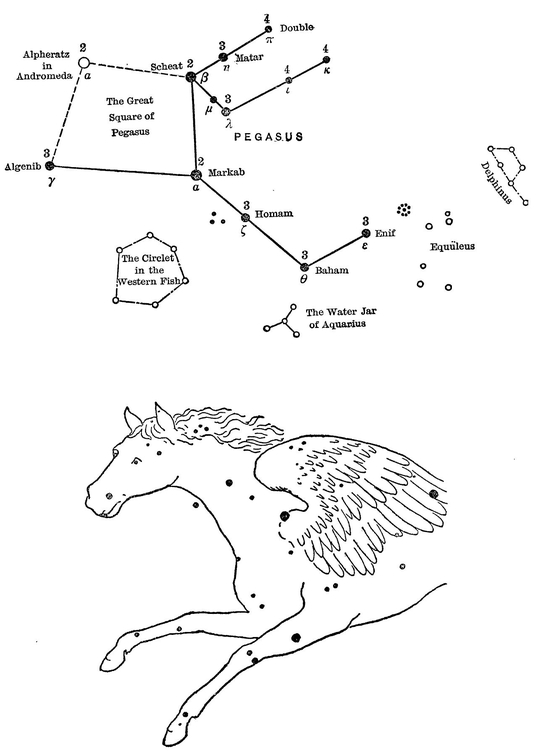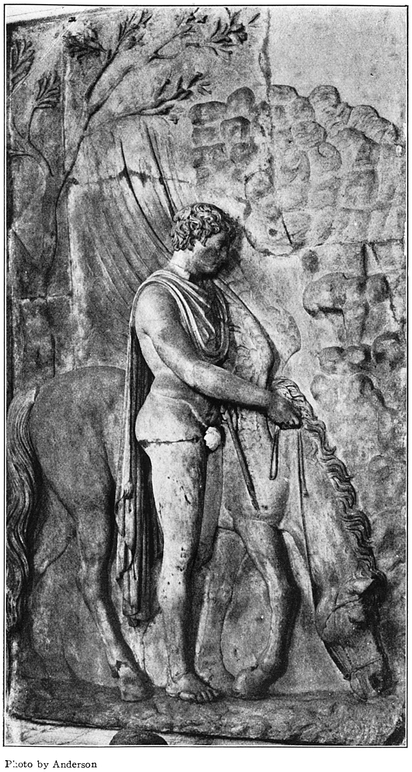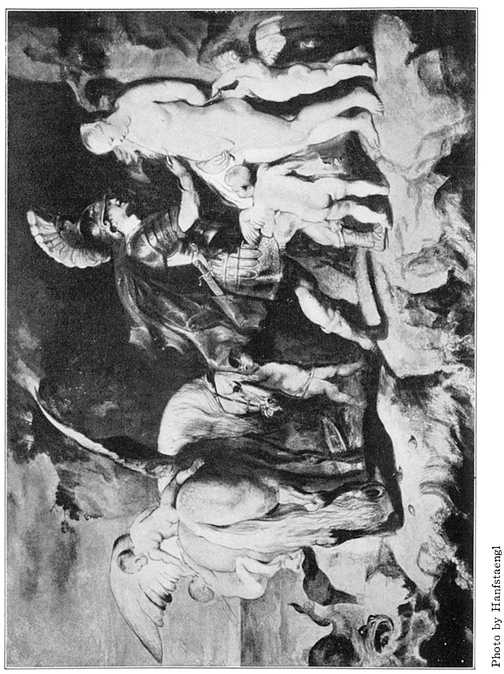Pegasus
The Flying Horse

PEGASUS
PEGASUS
THE FLYING HORSE
Then with nostrils wide distended,
Breaking from his iron chain,
And unfolding far his pinions,
To those stars he soared again.
LONGFELLOW’S “Pegasus in Pound.”
ONLY a part of the figure of a horse appears in this very ancient constellation, and, strangely enough, the horse is always represented reversed, with the forefeet pawing the sky. Pegasus is therefore often referred to as “The Demi-Horse,” or “the Half Horse”, the steed of the mighty Nimrod.
In mythology this is the celebrated horse that sprang from the blood of the Medusa, which dropped into the ocean after Perseus had severed her head.
According to Hesiod he received his name from his being born near the sources of the ocean, the name being derived from the Greek words πηγαι, meaning the “springs of the ocean,” or πηγoς, meaning “strong.”
Ovid claims Mount Helicon as the home of Pegasus. It was here that, by striking the ground sharply with his hoof, he caused the waters to gush forth, the fabled spring of “Hippocrene.”
The poetic steed
With beamy mane, whose hoof struck out from earth
The fount of Hippocrene.26
Bryant.
Pegasus was tamed by Neptune or Minerva, and was a great favourite with the Muses. He was given to Bellerophon, son of Glaucus, King of Ephyre, to aid him in conquering the Chimæra,
Bellerophon succeeded in destroying the monster, and then attempted to fly up to heaven on his winged steed. Jupiter, angered by his presumption, caused an insect to sting Pegasus, which brought about the fall of his rider. Wordsworth thus mentions the episode:
Bold Bellerophon (so Jove decreed
In wrath) fell headlong from the fields of air.
Pegasus, freed of his burden, continued his flight up to heaven, and Jupiter accorded him a place among the constellations.
It is said that Pegasus bears for Jupiter the lightning and thunder.
Now heav’n his further wand’ring flight confines,
Where, splendid with his num’rous stars, he shines.
Ovid’s Fasti.
The fact that Pegasus was especially favoured by the Muses has given rise to the expression often heard, “to mount Pegasus,” and every poet it is said must drink of the fountain created by his hoof blow, before he can expect to soar on Pegasean wing. As Spenser says:
Then whoso will with virtuous wing essay
To mount to heaven, on Pegasus must ride,
And with sweet Poet’s verse be glorified.
Brown regards Pegasus as the steed of Poseidon, the Charioteer, rising out of “the great deep,” or “sea,” as this region of the sky was called by the ancients.
Aratos gives us the following description of the Flying Horse:
He’s not four footed; with no hinder parts
And shown but half, rises the sacred Horse.

Bellerophon and Pegasus at Rome

Perseus and Andromeda Painting by Rubens
They say that he to lofty Helicon
Brought the pure spring of copious Hippocrene.
For upon Helicon no stream flowed down
Till the Horse smote it, there abundant waters
Gushed at the stamp of his fore-hoof. The shepherds
First called it Hippocrene, the Horse’s Fountain.
Still from the rock it pours not far from where
The Thespians dwell; thou seest it, but the Horse
Circles in heaven and there thou must behold him.
Plunket thinks there is some support in Grecian and in Vedic legend to be found for the opinion that the original position of Pegasus was upright, and not reversed. Though the Horse appears reversed on the Grecian astronomic sphere, he does not appear so on any artistic monument, vase, or coin.
In the Rig-Veda we read of a swift horse belonging to the Aswins, who, it is said, filled a hundred vases with sweet liquor, an allusion to the fount of Hippocrene.
Max Muller has pointed out that the Aswins possessed a horse called “Pagas,” and they are represented by the stars α and β Arietis. If we look at Pegasus in the sky, and observe how closely following that constellation the bright stars that mark the head of Aries appear, we shall easily understand how these Aswins might have, by Vedic bards, been imagined as possessing and driving in front of them the swift steed Pegasus.
As Pegasus is now represented in the heavens, his hoofs do not appear to touch any stellar representation of a fountain or vase, but if the figure is reversed, we find that the forefoot of the Horse would be close to the water-jar of Aquarius, the source of a great stream of water that flows down the steeps of the southern sky.
In the Aswameda hymns in the Rig-Veda, there is a reference to the sacrifice of a horse, and this is thought to refer to the symbolic sacrifice of the winged Horse of the constellation Pegasus.
Plunket thinks the legend of the fount of Hippocrene dates from 3000 B.C., and the invention of the constellation a thousand years earlier.
In regard to the reversal of the figure, the general opinion is that the figure of the Horse which has come down to us is the original design.
There is a special significance in the star groups that combine two figures in one, or depict merely half a figure. Thus we have the constellation of the Centaur, half man, half horse. This shows that the figure of the horse was familiar to the inventors of the constellations. In Pegasus we find only a half horse; there certainly were plenty of stars and space sufficient to depict the perfect figure, therefore there was some good reason for leaving it out.
Again, we find among the constellation figures half a Bull, only part of a Ship, and a Sea Goat, half fish, half goat. Whatever was the intention in thus depicting these star groups, they certainly furnish additional evidence of a deliberate plan in the minds of the designers and inventors of the star pictures, as everywhere else in the starry skies we find complete figures.
A suggestion has been made, that only half the Horse is shown because the other half is supposed to be obscured by clouds, and that the figure thus depicted conveys a better idea of a horse soaring to the skies. This view is certainly a plausible one.
Allen tells us that Ptolemy mentions the wings of the Horse as well recognised in his day. The winged horse appears to have been a favourite decorative figure, and appears on early Etruscan vases, and on many pieces of pottery found in the valley of the Euphrates. It also appears on coins of Corinth from 500 to 430 B.C. and on a well-known Hittite seal.
The Greeks called the constellation Iππoς, and in the Alphonsine Tables it was “Alatus,” meaning “winged.” Apparently at one time the foreleg of Pegasus was considerably extended, as π Cygni bears an Arab name signifying “the hoof of the horse. ”
Dr. Seiss regards Pegasus as representing the Messenger of Glad Tidings. Jewish legends made it the horse of the mighty Nimrod, and it is also said to represent the ass on which Christ rode in triumph into Jerusalem. Schiller thought this figure represented St. Gabriel.
Bochart claimed that the word Pegasus is a compound of the Phœnician “pag” or “pega,” and “sus,” meaning the Bridled Horse, used for the figurehead on a ship. It has also been said that Pegasus was of Egyptian origin, from “pag,” to cease, and “sus,” a vessel, thus symbolising the cessation of navigation at the change of the Nile flow. Here we find Pegasus regarded as the sky emblem of a ship in the very place in the heavens where we should expect to find a craft of some sort, in the part of the sky anciently called “the Sea.”
α Pegasi is known as “Markab,” an Arab word for a saddle or a ship. It might possibly be that Pegasus, a ship, is the reduplication of Argo, the constellation Ship. In the case of Argo, we find it stranded on a rock. Pegasus is close to the stream pouring from the water-jar of Aquarius, which may represent, as has been supposed, the Flood. It certainly seems more logical to regard Pegasus as a ship rather than half a horse, inasmuch as we have two equine figures in Centaur and Sagittarius, and only one ship, Argo. Reduplication plays such an important part in the constellation designs that we might well expect to find it applicable in the case of the Ship.
An imaginary line connecting α, β, and γ Pegasi and α Andromedæ, a star common to the constellations Andromeda and Pegasus, forms a quadrilateral known as “the Great Square of Pegasus,” one of the stellar landmarks.
α Pegasi, or Markab, is one of the so-called lunar stars much observed in navigation. In astrology it portended danger to life from cuts, stabs, and fire. It is on the meridian at 9 P.M. Nov. 3d.
γ Pegasi, called “Algenib,” meaning the “wing” or “side,” is one of “the Three Guides,” the stars that are situated almost on the prime meridian; the other two guides are α Andromedæ and β Cassiopeiæ.
ε, ξ, η, and θ Pegasi bear respectively the following Arab names: “Enif,” the nose, “Homam,” the lucky star, “Matar,” the fortunate rain, “Baham,” the good luck of the two beasts.
Most of the faint stars in the constellation have received individual names, an indication of the importance of the constellation in early times.
Within the area of the Great Square Argelander counted about thirty naked eye stars, while Schmidt, observing at Athens, counted one hundred and two.
The writer acknowledges his indebtedness to Prof. W. W. Campbell, of the Lick Observatory, for the following information concerning the stars that form the Great Square of Pegasus:
Alpha Andromedæ is a spectroscopic binary star whose two components revolve around their mutual centre of mass in ninety-seven days, and the system as a whole is approaching the solar system with a speed of 13 km. per second.
Alpha Pegasi is a spectroscopic binary. The observed velocity is variable, and not enough observations have been secured to determine the velocity of the system.27
Midway between the head of the Flying Horse and the Dolphin, is a rectangular-shaped figure composed of fourth and fifth magnitude stars, which forms the asterism known as “Equuleus,” “the Foal,” “the Little Horse,” or “the Horse’s Head. ”
The head only of this equine figure is represented, and like the winged Horse appears in an inverted position.
Geminus mentions Equuleus as having been formed by Hipparchus. Ptolemy catalogued it as Ιππoν πρoτoμ .The Arabs called it “Part of a Horse,” while with the Hindus it was another of their Aswini, “the Horsemen.”
.The Arabs called it “Part of a Horse,” while with the Hindus it was another of their Aswini, “the Horsemen.”
In mythology, according to Allen, Equuleus is said to represent Celeris, the brother of Pegasus, given by Mercury to Castor; or Cyllarus, given to Pollux by Juno, or the creature struck by Neptune’s trident from the earth when contesting with Minerva for superiority; but it also was connected with the story of Philyra and Saturn.
Cæsius thought that Equuleus represented the King’s Horse that Haman hoped for as told in the book of Esther. It was also thought to represent the mystic Rose.
The asterism comes to the meridian at 9 P.M. on the 24th of September.
δ Equulei is a triple and binary star. The two largest stars form a system noted as the quickest in orbital revolution of all the binaries in the heavens, save two. Its period according to Prof. Hussey is about 5.7 years. The components are so close that they can only be separated by the largest telescopes.